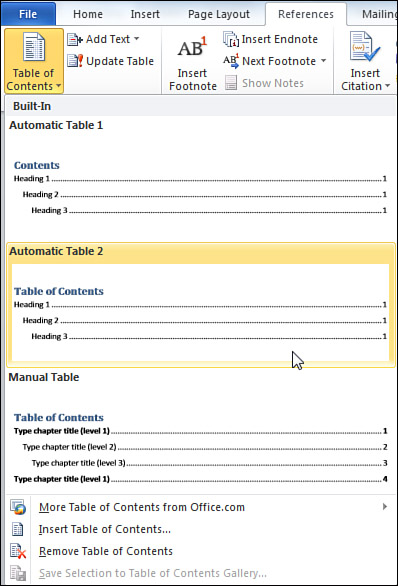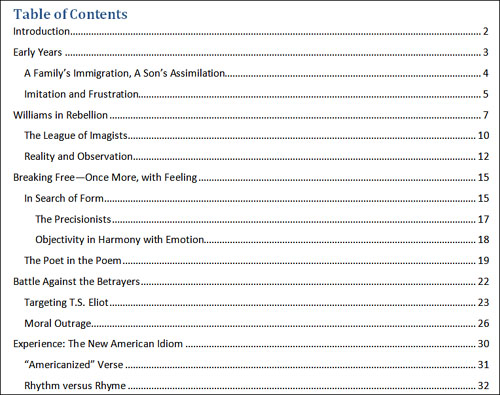A table of contents—or TOC, as we in the biz like to
call it—is a list of a document’s sections. The TOC shows each
section’s heading and page number.
Word can create a TOC from a document’s
headings—that is, if the headings are formatted with styles that Word
recognizes as heading styles. If your headings aren’t formatted with such styles, you’ll end up with an empty TOC.
The easiest way to add a TOC is to let Word insert a
preformatted one on a separate page at the beginning of the document.
After the table is in place, you can update it whenever you need to, in
case you revise, add, delete, or move a heading.
Adding a TOC to a Document
Word provides a handful of automatic tables of
contents, designed to complement your document’s theme. All you have to
do is pick the design you like; Word automatically inserts the TOC and
populates it with headings and page numbers. If you want more control
over the table’s appearance, you can use the Table of Contents dialog
box to create a custom TOC.
Inserting an Automatic Table of Contents
Before you create a table of contents, double-check your document’s headings to make sure they are formatted correctly.
1. | Place the insertion point at the beginning of the document and press Ctrl+Enter to insert a new, blank page there.
|
2. | Make sure the insertion point is on the new, blank page. Word inserts the TOC at the insertion point’s location.
|
3. | On
the References tab, click Table of Contents. A drop-down list displays
your options for inserting an automatic TOC, as shown in Figure 1.

|
To see if any other automatic TOCs are available,
click More Table of Contents From Office.com. A submenu appears,
displaying additional designs you can insert directly from the
Office.com website.
|
|
4. | Click one of the automatic table options. Word inserts the TOC at the insertion point’s location, as shown in Figure 2.

|
Automatic TOCs typically have a simple design. The
design includes a title formatted with the document’s Heading 1 style;
the list of section headings is formatted basically like normal text.
By default, automatic TOCs include only heading levels 1, 2, and 3.
|
A table of contents is one big field. If you start
messing with it (by manually formatting it, for example), its behavior
may surprise you. If you want to fiddle with your TOC, proceed with
caution and be ready to hit the Undo button at any time.
|